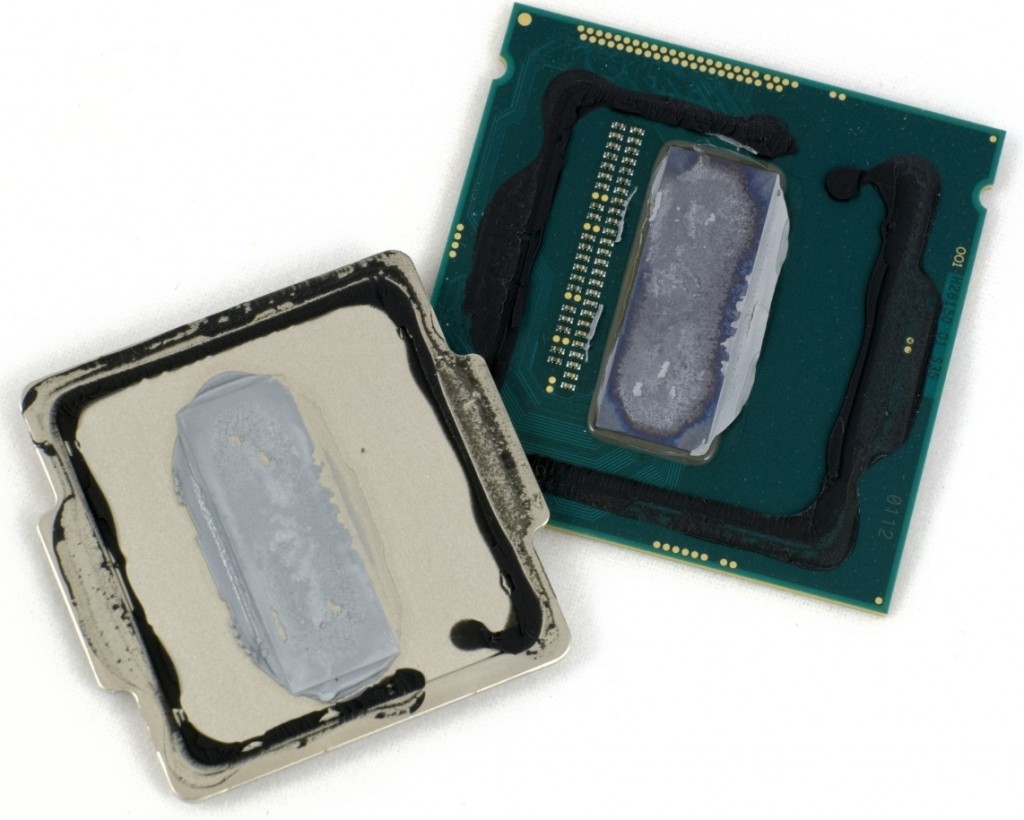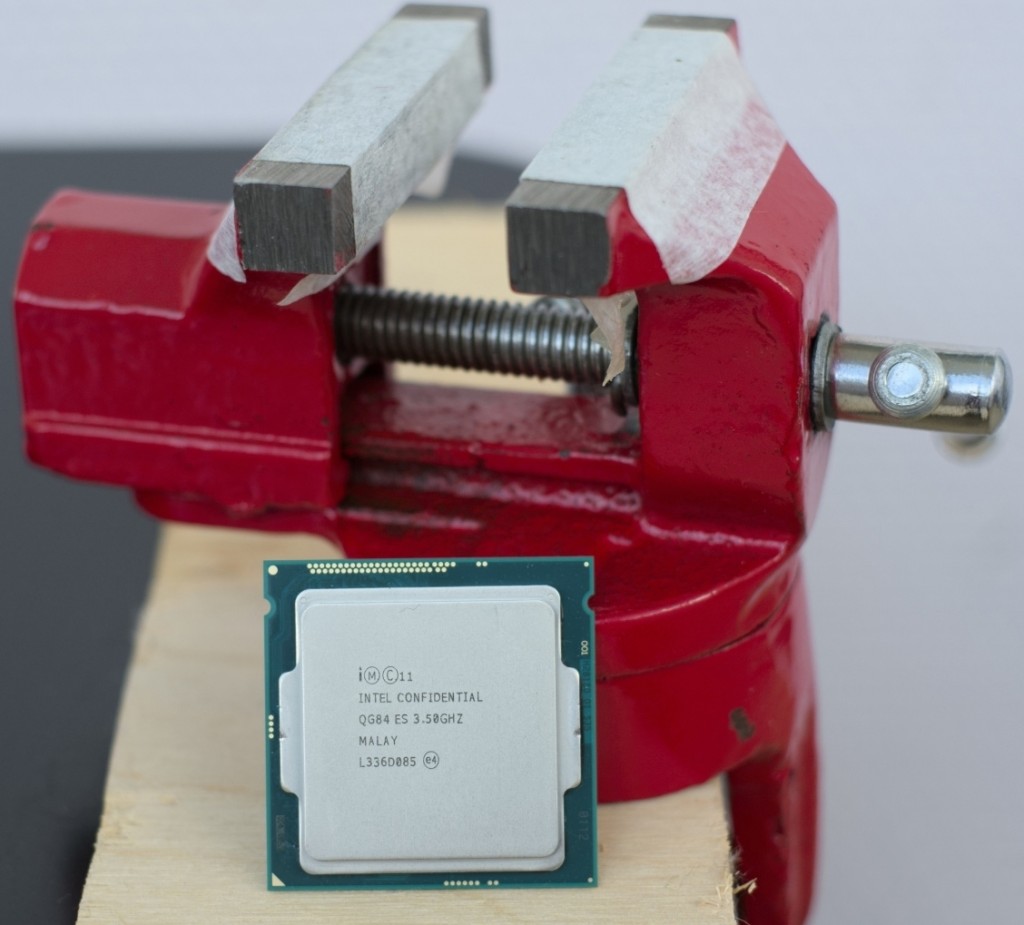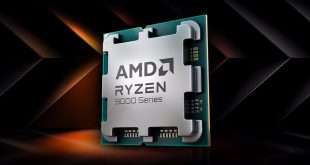Intel Corp.’s NGPTIM [next-generation polymer thermal interface material], which was supposed to bring back record overclocking capabilities to the company’s processors is better than its predecessor, but is significantly worse than commercially available thermal interfaces, a new research has found out.
Earlier this year Intel Corp.’s promised that its Core i7-4790K and Core i7-4690K “Devil’s Canyon” microprocessors will have considerably better overclocking potential compared to the original chips based on the “Haswell” micro-architecture released last year thanks to improved thermal interface between the die and the heat-spreader as well as revamped power supply circuity. However, actual overclocking attempts of a Core i7-4790K central processing unit by KitGuru’s reviewer Luke Hill did not reveal any breakthroughs. Apparently, the reason for that is quite simple: the new thermal interface that Intel uses still has limited efficiency.
All Intel processors for desktop computers in the recent 15+ years have featured heat-spreaders (which many call lids) on their dies to protect the latter from damages and enable more efficient heat dissipation. Back in the days Intel soldered dies to heat-spreaders using a special Indium-based alloy, which enabled very efficient transfer of heat. However, starting from the code-named Ivy Bridge microprocessors Intel replaced the solder with a layer of thermal paste, which is considerably less efficient than the previously used alloy.
Many overclockers complained that in order to unlock maximum overclocking potential of the Core i7-3770K and the Core i7-4770K microprocessors they had to remove the heat-spreaders (de-lid the chips) and change thermal interface. With the latest “Devil’s Canyon” central processing units Intel started to use a new substance called the NGPTIM, which is more efficient than its predecessors. However, a research conducted by 3DNews web-site has revealed that the NGPTIM is far less efficient than even affordable thermal pastes available on the market.
In a bid to test efficiency of the NGPTIM, Ilya Gavrichenkov, a renowned microprocessor expert, removed the lid and switched Intel’s NGPTIM with different thermal compounds. During the tests the base frequency of the Core i7-4690K processor was increased from 3.50GHz to 4.20GHz, the VCore was set at 1.2V and the TurboBoost 2.0 technology was disabled. The microprocessor was cooled-down by the Noctua NH-D15 cooler. The CPU temperatures were measured under two types of load: Extreme (created by AVX2-supporting LinX 0.6.5 stress test utility) and Typical (created by Freemake Video Converter 4.1.4 video transcoding software).
In both cases Intel’s NGPTIM could only outperform KPT-8 (an old thermal paste developed in 1974 in the USSR) paste and was less efficient than inexpensive Arctic Cooling MX-2. Highly-efficient Coollaboratory Liquid Pro compound proved to be dramatically better than Intel’s NGPTIM.
Usage of more efficient Coollaboratory Liquid Pro thermal paste allowed to overclock the Core i5-4690K processor to 4.60GHz with 1.46V voltage, which is 200MHz higher compared to a result with Intel’s new thermal interface.
The web-site proposes an interesting way to de-lid a processor using a bench-vice.
In other words, if you want to get maximum from Intel’s “Devil’s Canyon” chips, remove the heat-spreader and switch the NGPTIM with something better. While you will definitely lose warranty, you will finally get something that could be comparable to a good-old Sandy Bridge running at 5GHz.
Discuss on our Facebook page, HERE.
KitGuru Says: It is noteworthy that even with a new thermal compound the Core i7-4690K still did not skyrocket to 5GHz. Looks like modern micro-architectures are not really tailored for extreme overclocking…
 KitGuru KitGuru.net – Tech News | Hardware News | Hardware Reviews | IOS | Mobile | Gaming | Graphics Cards
KitGuru KitGuru.net – Tech News | Hardware News | Hardware Reviews | IOS | Mobile | Gaming | Graphics Cards









I think intel should just buy a giant bulk of the Liquid pro and use that instead of whatever shit they’re using.
What happened to the good old days when they used soder? What’s with this new paste bullshit I keep reading about with every new gen.
So, is there any way to bond the heat spreader back after replacing the TIM inside? Or is a delidding guide the only way out?
the Devils Canyon was supposed to be FOR overclockers……. they should have just soldered it, like Sandy Bridge.
jeez, your giving them £200 per chip, and they simply cant be arsed to even give you a satisfactory thermal paste, god forbid a good soldering
you would have to delid either way to get it there, and that’s the risky part.
I think you could, and as long as you don’t bent the lid there must be a way to get it to stick back how it was for protection (superglue drop?).
Even the best thermal paste needs to be swapped every couple of years, yet the average consumer would/could not do the swap under a CPU lid. I don’t see Coollab’s good paste lasting for five or so years. Don’t know if Intel’s paste lasts that long either but I think longevity has been focused more than performance when they engineered the paste to be used. Still think that they should never have stopped soldering their lids on the die though :/
You may mean Intel modern architectures, AMD processors are able to reach 5.0GHz easier as they have deep pipelines, smaller cores and they follow the speed demon approach. Intel cores are bigger, more complex with shallower pipelines and are harder to reach high clocks.
Most likely marketing PR, when they have no competition from AMD.
a few drops of epoxy works for me when deliding a CPU!
Intel = Purposely engineered to break
The real answer is metallurgical.
Using an IHS and paste like this prevents the die from cracking over time. Improves longevity, but trades performance as a result.
They could have used a better paste though.